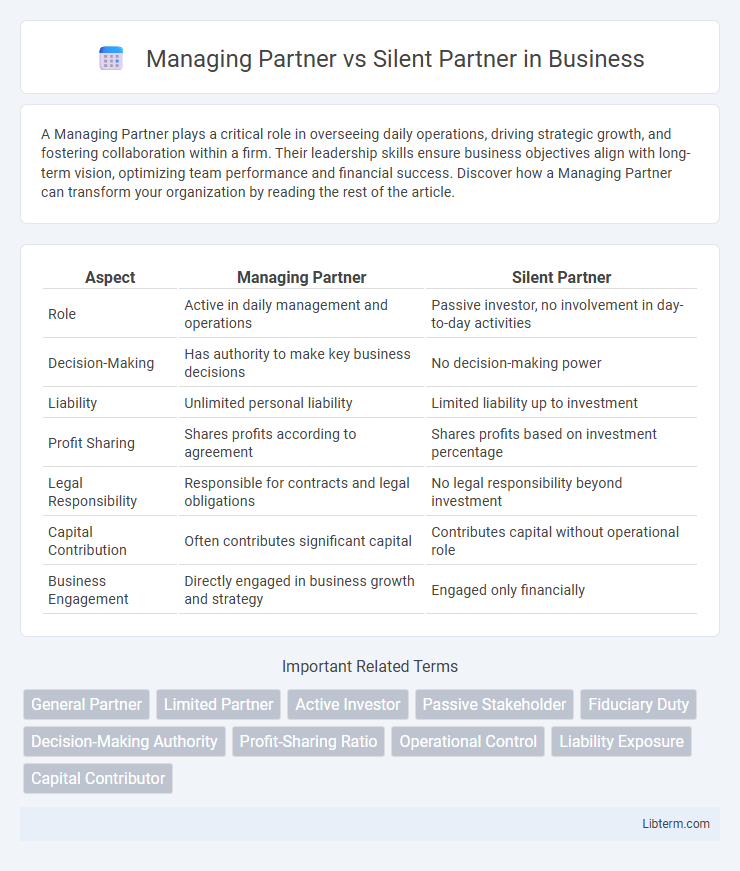A Managing Partner plays a critical role in overseeing daily operations, driving strategic growth, and fostering collaboration within a firm. Their leadership skills ensure business objectives align with long-term vision, optimizing team performance and financial success. Discover how a Managing Partner can transform your organization by reading the rest of the article.
Table of Comparison
| Aspect | Managing Partner | Silent Partner |
|---|---|---|
| Role | Active in daily management and operations | Passive investor, no involvement in day-to-day activities |
| Decision-Making | Has authority to make key business decisions | No decision-making power |
| Liability | Unlimited personal liability | Limited liability up to investment |
| Profit Sharing | Shares profits according to agreement | Shares profits based on investment percentage |
| Legal Responsibility | Responsible for contracts and legal obligations | No legal responsibility beyond investment |
| Capital Contribution | Often contributes significant capital | Contributes capital without operational role |
| Business Engagement | Directly engaged in business growth and strategy | Engaged only financially |
Understanding Partnership Structures
A Managing Partner actively participates in the daily operations and decision-making processes, bearing responsibility for the firm's management and legal obligations. In contrast, a Silent Partner invests capital but remains uninvolved in management, limiting liability and risk exposure. Understanding these roles clarifies partnership structures, governance, and liability distribution within business entities.
Defining the Managing Partner
The managing partner holds an active role in business operations, making strategic decisions and overseeing daily management, unlike a silent partner who invests capital without direct involvement. This partner possesses authority to bind the partnership contractually and assumes greater liability for the company's obligations. Their responsibilities typically include leadership, financial management, and steering overall growth.
Role and Responsibilities of a Managing Partner
A Managing Partner holds primary responsibility for the day-to-day operations, strategic decision-making, and overall management of the business, ensuring alignment with company goals and legal compliance. Unlike a Silent Partner, who invests capital but remains uninvolved in daily management and business decisions, the Managing Partner actively leads staff, oversees financial performance, and represents the firm in external relations. This role demands hands-on involvement in contract negotiations, business development, and resolving operational challenges to drive growth and sustainability.
Defining the Silent Partner
A silent partner is an investor in a business who contributes capital but remains uninvolved in daily operations or management decisions, limiting their liability to the extent of their investment. Unlike a managing partner who actively oversees business activities and makes strategic decisions, the silent partner's role is primarily financial, seeking returns without exposure to operational risks. This distinction influences partnership agreements, particularly regarding profit sharing, responsibility, and legal obligations.
Role and Responsibilities of a Silent Partner
A Silent Partner primarily invests capital in the business without participating in daily operations or decision-making processes, distinguishing their role from the active Managing Partner who handles management duties. Responsibility-wise, a Silent Partner shares in profits and losses but limits liability to their investment extent, avoiding involvement in liabilities arising from business management. Their role is crucial for financial support while maintaining anonymity and minimal engagement in company affairs.
Key Differences: Managing Partner vs Silent Partner
Managing partners actively participate in the day-to-day operations and decision-making of a business, bearing both management responsibilities and liabilities. Silent partners contribute capital and share profits but remain uninvolved in management and hold limited liability. The fundamental difference lies in the level of involvement and risk associated with business operations.
Legal and Financial Implications
A managing partner holds decision-making authority and bears fiduciary responsibilities, which expose them to personal liability for business debts and legal obligations, while a silent partner typically limits involvement to capital contributions, enjoying limited liability and reduced legal risk. Managing partners must actively engage in compliance with partnership agreements and regulatory requirements, whereas silent partners maintain a passive role without direct management duties or operational control. Financially, managing partners share profits and losses based on partnership terms but may also face greater exposure to creditor claims, unlike silent partners who generally limit losses to their invested capital.
Involvement in Daily Business Operations
Managing partners actively participate in daily business operations, making key decisions and overseeing management activities to drive company success. Silent partners contribute capital and share profits without engaging in the day-to-day management or operational responsibilities. The level of involvement in business operations significantly differentiates managing partners from silent partners in partnership structures.
Advantages and Disadvantages of Each Role
A Managing Partner holds decision-making authority, actively oversees business operations, and often contributes significant capital, offering advantages such as control and direct influence but facing the disadvantage of personal liability and increased workload. A Silent Partner provides capital investment without participating in daily management, benefiting from limited liability and reduced responsibility while sacrificing control and decision-making power. The choice between roles depends on whether an individual prioritizes operational control or passive investment with minimized risk exposure.
Choosing the Right Partnership for Your Business
Selecting the right partnership type significantly impacts your business control and liability exposure, with a managing partner actively overseeing daily operations and assuming full liability, while a silent partner invests capital without participating in management and limits liability to their investment. Understanding your desired level of involvement and risk tolerance helps determine whether a managing partner or silent partner structure aligns better with your business goals. Carefully evaluating each role's responsibilities and benefits ensures sustainable growth and effective decision-making in your partnership.
Managing Partner Infographic

 libterm.com
libterm.com